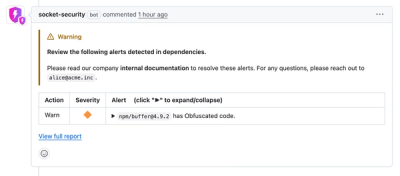
Security News
Crates.io Users Targeted by Phishing Emails
The Rust Security Response WG is warning of phishing emails from rustfoundation.dev targeting crates.io users.
ghost-google-cloud-storage-serve
Advanced tools
A simple plugin to add Google Cloud Storage support for Ghost Blog
A simple plugin to add Google Cloud Storage support for a Ghost Blog
cd /var/www/ghost # or wherever you ran ghost-cli, this is your ghost base directory
npm install --save ghost-google-cloud-storage
Note that if you do not have a package.json file in your ghost base directory, this will warn. You do not need to add one, the node_modules directory will be created and populated either way. You can create one by running npm init.
# This assumes that you are operating on your production environemnt, change the following variable if necessary.
export GHOST_ENVIRONMENT=production
# Your content path will be determined by your config file: https://docs.ghost.org/v1.0/docs/config#section-paths
# You can run the jq command to get it for you
export CONTENT_PATH=$(jq -r '.paths.contentPath // "."' config.${GHOST_ENVIRONMENT}.json)
mkdir -p ${CONTENT_PATH}/adapters/storage/gcloud
cat > ${CONTENT_PATH}/adapters/storage/gcloud/index.js << EOL
'use strict';
module.exports = require('ghost-google-cloud-storage');
EOL
Create a bucket in your google cloud project. In the storage settings you will find your project id as x-goog-project-id, after that you need to go to your API Credentials settings and create a Service account key, choosing JSON as the key type.
Add this key on your root ghost folder or any folder you want.
Add a storage block to your config.${GHOST_ENVIRONMENT}.json as below:
"storage": {
"active": "gcloud",
"gcloud": {
"projectId": "Your_project_id",
"key": "Your_key_path",
"bucket": "Your_bucket_name",
"assetDomain": "domain-for-bucket.example.com",
"insecure": true,
"maxAge": "2678400"
}
}
Notes:
assetDomain is an optional config entry, and is only required if you want to use a custom domain for your cloud storage bucket. Note that these instructions only allow for http, not https, as the storage servers do not present a custom certificate for your domain. Here is a list of workarounds. Pair with the "insecure": true option to use bare http URLs.insecure config is also optional, and defaults to false. Set to true if you are using a custom asset domain, and do not have https configured.maxAge is an optional config entry, and is only required if you want to set the cache-control's max age property. It defaults to 31 days (in seconds). This is desirable if you will not be deleting and re-uploading the same file multiple times, and will reduce your bandwidth usage when paired with a CDN. It can be overridden to set the max age to something else, smaller if you would like cache entries to be revalidated quicker, larger if you would like the cache entries to last for longer than 1 month.ghost stop
ghost run
You will see some logs or an error if the install was not successful. Fix any errors and then run ghost run again until you see the Ghost boot log entry.
ghost start
user@ghost:/var/www/ghost$ ghost stop
ghost run
Running sudo command: systemctl stop ghost_example-com
✔ Stopping Ghost
user@ghost:/var/www/ghost$ ghost run
The `ghost run` command is used by the configured Ghost process manager and for debugging. If you're not running this to debug something, you should run `ghost start` instead.
Running sudo command: node current/index.js
[2017-10-02 16:18:26] ERROR
NAME: IncorrectUsageError
CODE: MODULE_NOT_FOUND
MESSAGE: We have detected an error in your custom storage adapter.
level:critical
IncorrectUsageError: We have detected an error in your custom storage adapter.
at new IncorrectUsageError (/var/www/ghost/versions/1.10.0/node_modules/ghost-ignition/lib/errors/index.js:79:23)
at Object.getStorage (/var/www/ghost/versions/1.10.0/core/server/adapters/storage/index.js:43:19)
...
# fix the issue and retry
user@ghost:/var/www/ghost$ ghost run
The `ghost run` command is used by the configured Ghost process manager and for debugging. If you're not running this to debug something, you should run `ghost start` instead.
Running sudo command: node current/index.js
[2017-10-02 18:31:58] INFO Ghost is running in production...
[2017-10-02 18:31:58] INFO Your blog is now available on http://example.com/
[2017-10-02 18:31:58] INFO Ctrl+C to shut down
[2017-10-02 18:31:58] INFO Ghost boot 11.834s
^C[2017-10-02 18:32:02] WARN Ghost has shut down
[2017-10-02 18:32:02] WARN Your blog is now offline
user@ghost:/var/www/ghost$ ghost start
✔ Validating config
Running sudo command: systemctl start ghost_example-com
✔ Starting Ghost
You can access your blog at http://example.com
FAQs
A simple plugin to add Google Cloud Storage support for Ghost Blog
We found that ghost-google-cloud-storage-serve demonstrated a not healthy version release cadence and project activity because the last version was released a year ago. It has 1 open source maintainer collaborating on the project.
Did you know?

Socket for GitHub automatically highlights issues in each pull request and monitors the health of all your open source dependencies. Discover the contents of your packages and block harmful activity before you install or update your dependencies.

Security News
The Rust Security Response WG is warning of phishing emails from rustfoundation.dev targeting crates.io users.

Product
Socket now lets you customize pull request alert headers, helping security teams share clear guidance right in PRs to speed reviews and reduce back-and-forth.

Product
Socket's Rust support is moving to Beta: all users can scan Cargo projects and generate SBOMs, including Cargo.toml-only crates, with Rust-aware supply chain checks.